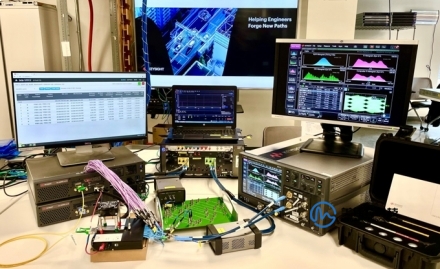FQA
2024.11.15
FQA
What is the difference between SR, LR, LRM, ER and ZR in 10G optical modules?
2024.07.09
SR, LR, LRM, ER and ZR are the more common module types in the 10GIEEE standard, but what is the difference between 10g SR, LR, LRM, ER and ZR? First we need to know what they represent. In fiber optic communication, SR, LR, LRM, ER and ZR are a kind of distance terminology in 10G optical module transmission, SR means short distance, LR means long distance, LRM means length extended multipoint mode, ER means ultra-long distance, and ZR means the longest distance.




FQA

24
2024-06
Yokogawa AQ6370D-12 vs AQ6370D-22 Spectrum Analyser Difference?
The main difference between the Yokogawa AQ6370D-12 and the AQ6370D-22 lies in their model numbers and possible differences in features or specifications?The Yokogawa AQ6370D series consists of several models, such as the AQ6370D-02, the AQ6370D-12 and the AQ6370D-22.
FQA

24
2024-06
Difference between Yokogawa AQ6370E 10 and AQ6370E 20 spectrometer?
Yokogawa AQ6370E 10 and AQ6370E 20 are both spectrum analysers manufactured by Yokogawa, they belong to the same series but are different. According to the search results, the AQ6370E 20 is the high-performance version with higher wavelength accuracy and dynamic range, as well as more advanced measurement modes and higher stray light rejection. Specifically, the AQ6370E 20 has higher wavelength accuracy and dynamic range, providing more accurate and clearer spectral measurements.
FQA

13
2024-06
Keysight N1092A Series What factors in eye chart testing affect the accuracy of test results?
The N1092A Keysight DCA-M Sampling Oscilloscope supports a variety of functions such as eye diagram testing and optical module/cat testing. Here are the basic steps for eye diagram testing with the N1092A: When performing Keysight N1092A eye diagram testing, a variety of factors may affect the accuracy of the test results. The following are some of the key factors:
FQA

11
2024-06
Difference between KEYSIGHT N1000A and KEYSIGHT 86100D?
The N1000A and 86100D are similar in design concept and application areas, both being used for accurate measurement of high-speed digital designs. However, the N1000A, being a newer product, has improved sampling rate and performance, and supports a wider range of module types. If you need higher performance and wider module compatibility, the N1000A may be a better choice. If your application scenario prefers the classic 86100D, it is still a solid choice!
FQA

11
2024-06
KEYSIGHT N1000A Sampling Oscilloscope What types of modules are supported?
The N1000A Keysight high-performance wide bandwidth oscilloscope, which supports a wide range of module types that can be selected and configured to perform precision optical, electrical, and TDR/TDT/S parametric analyses based on the user's needs. The following are some of the supported module types
FQA

11
2024-06
What major wireless communication technology standards does the R&S ® CMW500 support?
The CMW 500 is a broadband radio communications tester manufactured by Rohde & Schwarz. It supports signalling for a wide range of radio access technologies including, but not limited to, LTE, WCDMA, GSM, WLAN, Bluetooth, etc. The CMW 500 is capable of LTE-Advanced testing and supports up to 8 Downlink Carrier Convergence (DL CC), up to 4x4/8x2 MIMO fading, and 2 Uplink Carrier Aggregation (UL CA).
FQA

07
2024-06
10G Optical Module Eye Diagram Testing in a Nutshell
10G optical module eye diagram test is an important means to evaluate the performance of optical modules, which is a method to obtain the performance parameters of optical modules by monitoring and analysing the optical signals in real time. During the testing process, the optical signal is converted into an electrical signal and displayed through the waveform of an oscilloscope. By analysing the waveform, various parameters of the eye diagram, such as eye height, eye width, extinction ratio, etc., can be obtained to evaluate the performance of the optical module.
FQA

04
2024-06
Keysight E8257D PSG Analogue Signal Generator FQA
The Keysight E8257D covers a wide frequency range from 230 kHz to 47 GHz and operates over a temperature range of 0 to 55°C, requiring a 45-minute warm-up time to meet its specifications.
The E8257D also has powerful modulation capabilities for a variety of modulation operations. It is typically equipped with 14 MB of flash memory for easy data storage and management. The device is widely used in electronic measurements, communications, radar, sound and image processing.
The E8257D also has powerful modulation capabilities for a variety of modulation operations. It is typically equipped with 14 MB of flash memory for easy data storage and management. The device is widely used in electronic measurements, communications, radar, sound and image processing.
FQA

15
2024-05
Information about CDR clock recovery devices in communication systems?
The Clock Recovery Device (CDR: Clock and Data Recovery) is a very critical component in a communication system. Its main function is to extract clock information from the received signals in order to sample and retime the data correctly. This process is critical to ensure the accuracy and reliability of data transmission.








